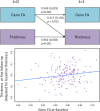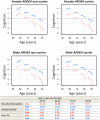Amyloid, Vascular, and Resilience Pathways Associated with Cognitive Aging
- PMID: 31509621
- PMCID: PMC6899909
- DOI: 10.1002/ana.25600
Amyloid, Vascular, and Resilience Pathways Associated with Cognitive Aging
Abstract
Objective: To investigate the multifactorial processes underlying cognitive aging based on the hypothesis that multiple causal pathways and mechanisms (amyloid, vascular, and resilience) influence longitudinal cognitive decline in each individual through worsening brain health.
Methods: We identified 1,230 elderly subjects (aged ≥50 years) with an average of 4.9 years of clinical follow-up and with amyloid positron emission tomography, diffusion tensor imaging, and structural magnetic resonance imaging scans from the population-based Mayo Clinic Study of Aging. We examined imaging markers of amyloid and brain health (white matter microstructural integrity and cortical thinning), systemic vascular health preceding the imaging markers, and early to midlife intellectual enrichment to predict longitudinal cognitive trajectories. We used latent growth curve models for modeling longitudinal cognitive decline.
Results: All the pathways (amyloid, vascular, resilience) converged through their effects on cortical thinning and worsening cognition and together explained patterns in cognitive decline. Resilience and vascular pathways (aging process, sex differences, education/occupation, and systemic vascular health) had significant impact on white matter microstructural integrity. Education/occupation levels contributed to white matter integrity through systemic vascular health. Worsening white matter integrity contributed to significant cortical thinning and subsequently longitudinal cognitive decline. Baseline amyloidosis contributed to a significant proportion of cognitive decline that accelerated with longer follow-up times, and its primary impact was through cortical thinning.
Interpretation: We developed an integrated framework to help explain the dynamic and complex process of cognitive aging by considering key causal pathways. Such an approach is important for both better comprehension of cognitive aging processes and will aid in the development of successful intervention strategies. ANN NEUROL 2019;86:866-877.
© 2019 The Authors. Annals of Neurology published by Wiley Periodicals, Inc. on behalf of American Neurological Association.
Conflict of interest statement
Nothing to report.
Figures





Similar articles
-
Vascular and amyloid pathologies are independent predictors of cognitive decline in normal elderly.Brain. 2015 Mar;138(Pt 3):761-71. doi: 10.1093/brain/awu393. Epub 2015 Jan 15. Brain. 2015. PMID: 25595145 Free PMC article.
-
Amyloid and FDG PET of Successful Cognitive Aging: Global and Cingulate-Specific Differences.J Alzheimers Dis. 2018;66(1):307-318. doi: 10.3233/JAD-180360. J Alzheimers Dis. 2018. PMID: 30282358 Free PMC article.
-
Development of a cerebrovascular magnetic resonance imaging biomarker for cognitive aging.Ann Neurol. 2018 Nov;84(5):705-716. doi: 10.1002/ana.25346. Epub 2018 Oct 25. Ann Neurol. 2018. PMID: 30264411 Free PMC article.
-
Emerging concepts in sporadic cerebral amyloid angiopathy.Brain. 2017 Jul 1;140(7):1829-1850. doi: 10.1093/brain/awx047. Brain. 2017. PMID: 28334869 Free PMC article. Review.
-
A viewpoint on change point modeling for cognitive aging research: Moving from description to intervention and practice.Ageing Res Rev. 2020 Mar;58:101003. doi: 10.1016/j.arr.2019.101003. Epub 2019 Dec 24. Ageing Res Rev. 2020. PMID: 31881367 Free PMC article. Review.
Cited by
-
Predicting resistance to amyloid-beta deposition and cognitive resilience in the oldest-old.Neurology. 2020 Aug 25;95(8):e984-e994. doi: 10.1212/WNL.0000000000010239. Epub 2020 Jul 22. Neurology. 2020. PMID: 32699143 Free PMC article.
-
Association of years to parent's sporadic onset and risk factors with neural integrity and Alzheimer biomarkers.Neurology. 2020 Oct 13;95(15):e2065-e2074. doi: 10.1212/WNL.0000000000010527. Epub 2020 Jul 31. Neurology. 2020. PMID: 32737076 Free PMC article.
-
Atypical Hierarchical Connectivity Revealed by Stepwise Functional Connectivity in Aging.Bioengineering (Basel). 2023 Oct 6;10(10):1166. doi: 10.3390/bioengineering10101166. Bioengineering (Basel). 2023. PMID: 37892896 Free PMC article.
-
WMH Contributions to Cognitive Impairment: Rationale and Design of the Diverse VCID Study.Stroke. 2025 Mar;56(3):758-776. doi: 10.1161/STROKEAHA.124.045903. Epub 2024 Nov 15. Stroke. 2025. PMID: 39545328 Review.
-
Vascular cognitive impairment: Advances in clinical research and management.Chin Med J (Engl). 2024 Dec 5;137(23):2793-2807. doi: 10.1097/CM9.0000000000003220. Epub 2024 Jul 24. Chin Med J (Engl). 2024. PMID: 39048312 Free PMC article. Review.
References
Publication types
MeSH terms
Substances
Supplementary concepts
Grants and funding
- C06 RR018898/GF/NIH HHS/United States
- R01 AG041851/AG/NIA NIH HHS/United States
- R01 AG056366/AG/NIA NIH HHS/United States
- R01 AG011378/AG/NIA NIH HHS/United States
- R37 AG011378/AG/NIA NIH HHS/United States
- U01 AG006786/AG/NIA NIH HHS/United States
- P50 AG016574/GF/NIH HHS/United States
- R01 AG034676/AG/NIA NIH HHS/United States
- R37 AG011378/GF/NIH HHS/United States
- ALZ/Alzheimer's Association/United States
- R01 AG034676/GF/NIH HHS/United States
- R01 NS097495/NS/NINDS NIH HHS/United States
- P30 AG062677/AG/NIA NIH HHS/United States
LinkOut - more resources
Full Text Sources
Medical

